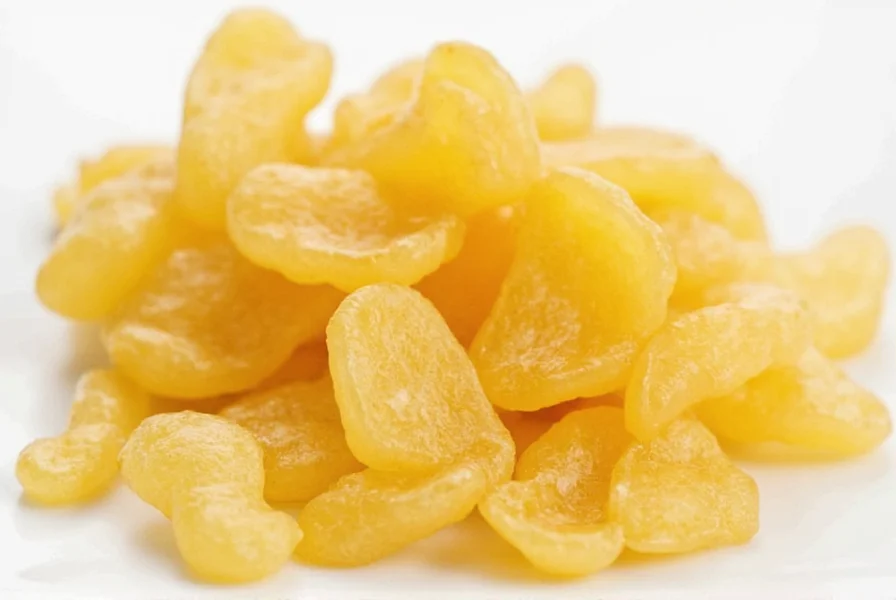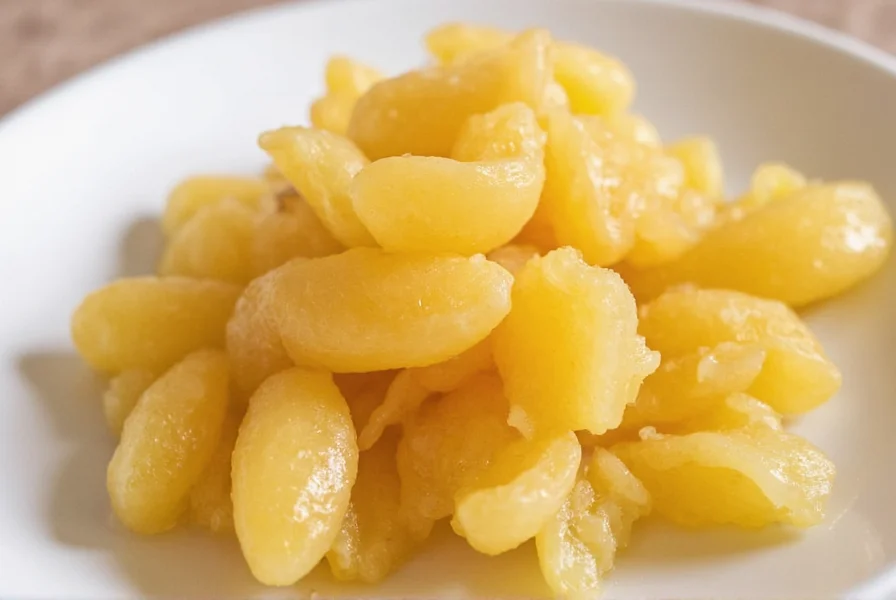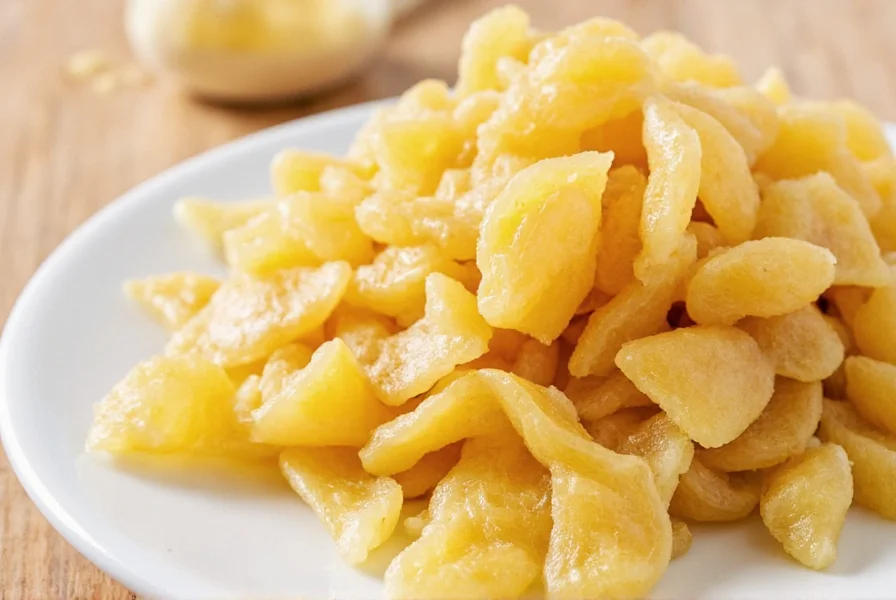Candied ginger offers a distinctive flavor profile that bridges the gap between spicy and sweet. Unlike fresh ginger with its sharp bite or ground ginger with its concentrated heat, candied ginger provides a more mellow yet complex experience. The preservation process transforms the fibrous root into a tender, chewy confection that maintains ginger's characteristic warmth while introducing a pleasant sugary counterpoint.
The Traditional Production Process
The creation of candied ginger follows a time-honored method that balances preservation with flavor development. Fresh ginger root undergoes careful peeling and slicing before entering the candying process. Producers simmer the ginger slices in a sugar syrup solution, typically maintaining a precise temperature between 200-210°F (93-99°C) to ensure proper infusion without cooking the ginger to mush.
As the ginger simmers, osmosis occurs—the sugar syrup gradually replaces the ginger's natural moisture. This process takes approximately 45-60 minutes, with careful monitoring to prevent overcooking. Once the ginger reaches the desired tenderness and sugar saturation, producers remove it from the syrup and allow it to drain. The final step involves rolling the pieces in additional sugar crystals, creating the signature crystallized exterior that distinguishes high-quality candied ginger.

Culinary Applications and Pairings
Candied ginger's versatility extends far beyond simple snacking. Professional chefs and home cooks alike value it for its ability to enhance both sweet and savory dishes. When finely chopped, it adds complexity to baked goods like gingerbread, cookies, and fruitcakes. The sugar content caramelizes during baking, creating nuanced flavor notes that ground ginger cannot replicate.
For those exploring how to use candied ginger in baking, consider these applications:
| Dish Type | Recommended Preparation | Quantity per Recipe |
|---|---|---|
| Cookies & Bars | Finely diced | 1/4 to 1/2 cup |
| Cakes & Muffins | Small cubes | 1/3 to 2/3 cup |
| Glazes & Sauces | Pureed | 2-3 tablespoons |
| Savory Dishes | Thinly sliced | 2-4 tablespoons |
The difference between candied ginger and crystallized ginger often causes confusion. While the terms are frequently used interchangeably, true crystallized ginger undergoes an additional step where the sugared ginger dries completely, forming larger sugar crystals. Most commercial products labeled as "candied ginger" are actually crystallized, featuring that characteristic crunchy sugar coating.
Health Considerations and Research
When examining the health benefits of candied ginger, it's important to distinguish between the properties of ginger itself and the impact of the sugar preservation process. Fresh ginger contains gingerol, a bioactive compound with documented anti-inflammatory properties. However, the candying process significantly increases sugar content while potentially reducing some volatile compounds.
Research suggests that while candied ginger retains some beneficial compounds, its sugar content means it shouldn't be considered a health food. Those seeking ginger's potential digestive benefits might find fresh ginger tea more appropriate. That said, the small amounts typically consumed in culinary applications make candied ginger a reasonable occasional treat, particularly for those exploring natural remedies for candied ginger for nausea relief during travel.
Storage and Shelf Life Optimization
Proper storage significantly impacts the quality and longevity of candied ginger. Unlike fresh ginger, which requires refrigeration, properly made candied ginger can be stored at room temperature when kept in an airtight container away from moisture. The sugar acts as a natural preservative, creating an environment inhospitable to microbial growth.
For optimal storage tips for candied ginger, follow these guidelines:
- Store in an airtight container with parchment paper between layers
- Keep in a cool, dark place (not the refrigerator, which introduces moisture)
- Consume within 6-8 months for best quality
- Revive slightly hardened pieces by placing a slice of bread in the container overnight
Commercial products often contain citric acid or other preservatives to extend shelf life, while homemade versions typically last 3-4 months under proper storage conditions.
Homemade Production Guide
Creating homemade candied ginger allows for complete ingredient control and customization. The basic process requires only three ingredients: fresh ginger, sugar, and water. Many enthusiasts seek candied ginger recipe without corn syrup options, which is easily achievable using a simple sugar-water syrup.
For best results, select young ginger with thin skin and minimal fiber. Peel thoroughly and slice into uniform 1/8-inch pieces. Combine equal parts sugar and water (by weight) in a saucepan, add ginger, and simmer gently. The key to perfect texture lies in the simmering time—too short and the ginger remains fibrous, too long and it becomes mushy.

Creative Applications Beyond the Kitchen
While primarily a culinary ingredient, candied ginger finds surprising applications in other areas. Some crafters use it in potpourri blends for its warm, spicy aroma. Others incorporate small pieces into homemade soaps and bath products for gentle exfoliation and fragrance.
For tea enthusiasts, candied ginger provides a convenient way to add ginger flavor to beverages. Simply drop a small piece into hot water and allow it to dissolve gradually. This method creates a naturally sweetened ginger tea without additional sugar—a popular option among those seeking natural remedies for occasional digestive discomfort.
Frequently Asked Questions
What's the difference between candied ginger and stem ginger?
Candied ginger is preserved in sugar syrup and coated with sugar crystals, creating a sweet, chewy texture. Stem ginger refers to young ginger preserved in syrup but not crystallized, typically sold in jars submerged in liquid syrup. Stem ginger has a moister texture and less concentrated sweetness than candied ginger.
Can I substitute candied ginger for fresh ginger in recipes?
Substitution requires careful adjustment. One tablespoon of finely chopped candied ginger generally equals 1/2 teaspoon of fresh grated ginger, but you must also reduce added sugar in the recipe by approximately 1-2 teaspoons per tablespoon of candied ginger used. The texture and moisture content differ significantly, so substitutions work best in recipes where texture isn't critical.
Is candied ginger gluten-free and suitable for special diets?
Pure candied ginger made with just ginger, sugar, and water is naturally gluten-free, vegan, and paleo-friendly. However, always check labels as some commercial varieties may contain corn syrup, citric acid, or other additives. For those following strict dietary protocols, homemade versions provide complete ingredient control.
How can I use candied ginger in savory dishes without making them too sweet?
To incorporate candied ginger into savory applications while minimizing sweetness, use smaller quantities and balance with acidic elements. Finely mince the ginger and pair it with citrus juice, vinegar, or tomatoes. In marinades, combine with soy sauce, garlic, and chili for Asian-inspired dishes. The ginger's heat will complement savory flavors while the sugar content caramelizes during cooking, creating complex umami notes rather than overt sweetness.
Why does my homemade candied ginger become sticky over time?
Stickiness typically occurs when the sugar syrup hasn't reached the proper concentration during cooking or when storage conditions expose the ginger to moisture. Ensure your syrup reaches 220°F (104°C) before adding ginger, and allow pieces to dry completely (8-12 hours) before storing. Use an airtight container with silica gel packets to absorb excess moisture, and avoid refrigeration which introduces humidity.











 浙公网安备
33010002000092号
浙公网安备
33010002000092号 浙B2-20120091-4
浙B2-20120091-4